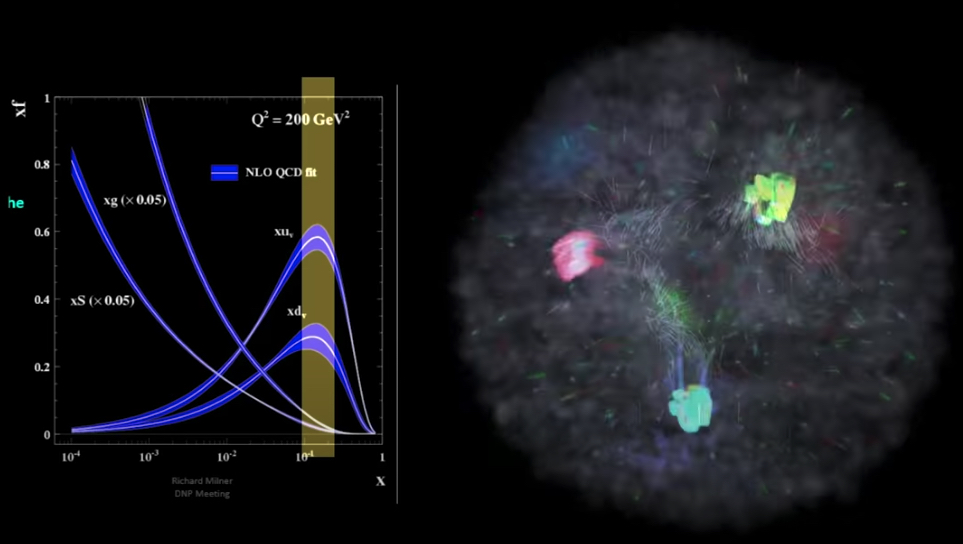Nuclear physicists partner with visual artists for a science-based animation of the landscape inside the ubiquitous proton
The nearly 1,700 nuclear physicists who conduct their research at the U.S. Department of Energy’s Thomas Jefferson National Accelerator Facility are experts on the proton. Yet, when you ask them what the inside of a proton actually looks like, you are likely to get wildly different descriptions.
All of those CSI shows make it look easy: If you want to see something up close, just shove it under a microscope. But simple light microscopes have their limits. The proton is about one hundred million times smaller than the shortest wavelengths of visible light. Rather than rebounding from the proton, ordinary light waves are so big that the proton floats among them without so much as a ripple.
Nuclear physicists have found a way around that by turning to a kind of virtual light. Electrons are smaller than protons. Electrons can approach the protons and interact with them by emitting virtual packets of light, called virtual photons, that can probe the proton's interior. At this scale, there are even virtual photons that can go under the proton’s surface to provide information about what’s inside.
In this way, electrons and their virtual photons have become the light that allows physicists to virtually “see” inside the proton. But what they get back aren’t tidy pictures or videos. Instead, the information they get amounts to a point of information that may be connected at different scales to form sweeping curves on a graph.
To help interpret what those curves would look like if we could actually see the proton, nuclear physicists at Jefferson Lab and MIT turned to visual artists to conceptualize a representation of the proton and its inner workings.
“We had a huge body of data accumulated on proton structure but did not have a good visualization of what these data were telling us. Instead, if one searched for a proton on the internet you either would have found a car or a cartoon with three blobs inside,” said Rolf Ent, Jefferson Lab’s EIC co-associate director.
The team includes three nuclear physicists who have long been a part of the Jefferson Lab community: Ent, Jefferson Lab; Rik Yoshida, formerly Jefferson Lab and now at DOE’s Argonne National Lab; and Richard Milner, MIT. The team also includes two MIT documentary filmmakers, Chris Boebel and Joe McMaster, and an animator at Sputnik Animation, James LaPlante.
The work was funded in part by Jefferson Lab and a grant from the MIT Center for Art, Science & Technology (CAST), which included not only the animation itself, but also a documentary of how physicists interpret the sweeping curves they have produced from their data and transform them into a visualization of the proton, as well as a film on how this visualization process was carried out.
“The visualizations are a mix of science and art, as the body of data we have up to now cannot really constrain the innermost 3D structure of protons as made of quarks and gluons. It is a surreal world with much of (relativistic) motion and quarks and gluons continuously appearing and disappearing, with huge forces to bind them into the matter we know,” explained Ent.
Among them, the team was able to bring to life an animation on the wealth of data obtained from Jefferson Lab and other research facilities on what the proton looks like and how it’s building blocks interact at different scales (resolution).
“CEBAF is paving the trail to now obtain a 3D movie of the spatial distribution and motion of the basic quarks that make the proton’s identity,” Ent said. “In the future, the EIC will show how a 3D movie will look like when we enter the world teeming with the gluons that bind them. Without these tiny particles at the heart of all matter, our physical world would not exist.”
You can watch the animation itself and a video that describes how the data were interpreted for the animation on YouTube. An in-depth feature article on the project is also available on the MIT website, and a more detailed feature film on the project is expected in the coming months.
Further Reading
“Visualizing the Proton” through animation and film
Visualizing the Proton: Charting the Inner Structure of the Proton video
“Visualizing the Proton” Animation
Contact: Kandice Carter, Jefferson Lab Communications Office, kcarter@jlab.org


